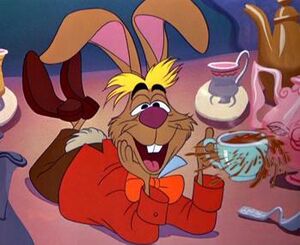March Hare facts for kids
Quick facts for kids March Hare |
|
|---|---|
| Alice character | |

The March Hare. Illustration by John Tenniel.
|
|
| First appearance | Alice's Adventures in Wonderland |
| Last appearance | Through the Looking-Glass |
| Created by | Lewis Carroll |
| Information | |
| Aliases | Haigha |
| Species | Hare |
| Gender | Male |
| Occupation | Host of the Mad Tea Party Messenger |
| Nationality | Wonderland |
The March Hare is a famous character from Lewis Carroll's book Alice's Adventures in Wonderland, published in 1865. He is best known for hosting a very unusual tea party with the Mad Hatter and the Dormouse.
In Through the Looking-Glass, he appears again, but this time he is called Haigha. Alice, the main character, wonders if he will still be "mad" when she meets him.
Contents
Why is the March Hare "Mad"?
The March Hare's name comes from a common saying, "Mad as a March hare." This phrase was popular in England long before Lewis Carroll wrote his books. It means someone is very silly or crazy.
People used to believe that hares acted strangely in March. This is because March is the start of their breeding season. During this time, female hares sometimes fight off males that are too eager. People thought these fights were between males, making them seem "mad."
The Never-Ending Tea Party
The March Hare and his friend, the Mad Hatter, are stuck in a never-ending tea party. This is because the Hatter supposedly upset the Queen of Hearts. He was singing for her, but she said he was "murdering the time." Because of this, Time stopped for them, and it's always tea-time!
In John Tenniel's original drawings for the book, the March Hare has straw on his head. In Victorian times, this was a common way to show that someone was mad or crazy.
The March Hare also shows up at the trial of the Knave of Hearts. Later, as "Haigha," he works as a messenger for the White King in Through the Looking-Glass. Alice doesn't seem to recognize him, or she chooses not to say anything about it.
The March Hare in Other Stories
The March Hare has appeared in many other books, movies, and games inspired by Alice's adventures.
Alice in Verse
In the book Alice in Verse: The Lost Rhymes of Wonderland, the March Hare has a different role. Instead of being a nervous witness at the trial, he becomes the prosecutor. He gives a speech that actually defends the person accused. Then, he even criticizes the court for not serving tea with the evidence!
Alice in the Country of Hearts
In the Japanese manga series Alice in the Country of Hearts, the March Hare is a character named Elliot March. He looks mostly human but has two brown rabbit ears. Elliot is the right-hand man to Blood Dupre, who is like the Hatter.
Elliot doesn't like being called a rabbit. He often gets upset and says his ears are "just bigger than average." He isn't exactly mad, but he can be a bit violent at first. However, as the story continues, Elliot is shown to be a sweet and funny character.
Pandora Hearts
Another Japanese manga, Pandora Hearts, features the March Hare as a "Chain." A Chain is a special being that forms a bond with a "Contractor." The March Hare's Contractor is Reim Lunettes.
This March Hare Chain can pretend to be dead, which helps Reim escape danger. It's described as a "gentle Chain" and not meant for fighting. This is a bit different from how the March Hare is usually shown, as a mad or crazy character.
The March Hare in Disney Films
The March Hare has been a part of several Disney productions.
Disney's Animated Film
In Disney's 1951 animated movie, Alice in Wonderland, the March Hare is very confused and silly. He keeps offering Alice tea, but then he pulls the cup away or takes it from her just as she tries to drink.
The voice actor, Jerry Colonna, also inspired the March Hare's look and personality in the film. This version of the character also appeared in TV shows like Bonkers and House of Mouse.
Tim Burton's Alice in Wonderland
The March Hare appears in Tim Burton's 2010 Disney movie, Alice in Wonderland. He is voiced by Paul Whitehouse. His full name is Thackery Earwicket, though this name isn't used in the movie.
In this film, the March Hare is always nervous and very wild. He works as a cook and throws dishes and pots around in a crazy way. This makes him a mix of the March Hare and the cook from Lewis Carroll's original book. He has a strong Scottish accent in the movie.
Thackery hosts the tea party at his "Hare House" windmill. He is joined by the Mad Hatter, the Dormouse, and the Cheshire Cat. He also appears in the White Queen's kitchen, cooking wildly. Later, he stands with other characters, ready for battle with a ladle as his weapon.
The March Hare in Games
The March Hare also appears in several video games.
- In the game American McGee's Alice, the March Hare has been changed by the Mad Hatter's experiments. He and the Dormouse are now part-robot, or clockwork cyborgs.
- He also appears in Alice: Madness Returns, which is a sequel to American McGee's Alice.
- In the video game based on Tim Burton's movie, Thackery Earwicket is a character you can play as. He can use telekinesis to move things with his mind. He throws dishes as his main attack and also uses his big ears and feet as weapons. He uses his telekinesis to defeat the Bandersnatch.
See also
 In Spanish: Liebre de Marzo para niños
In Spanish: Liebre de Marzo para niños



